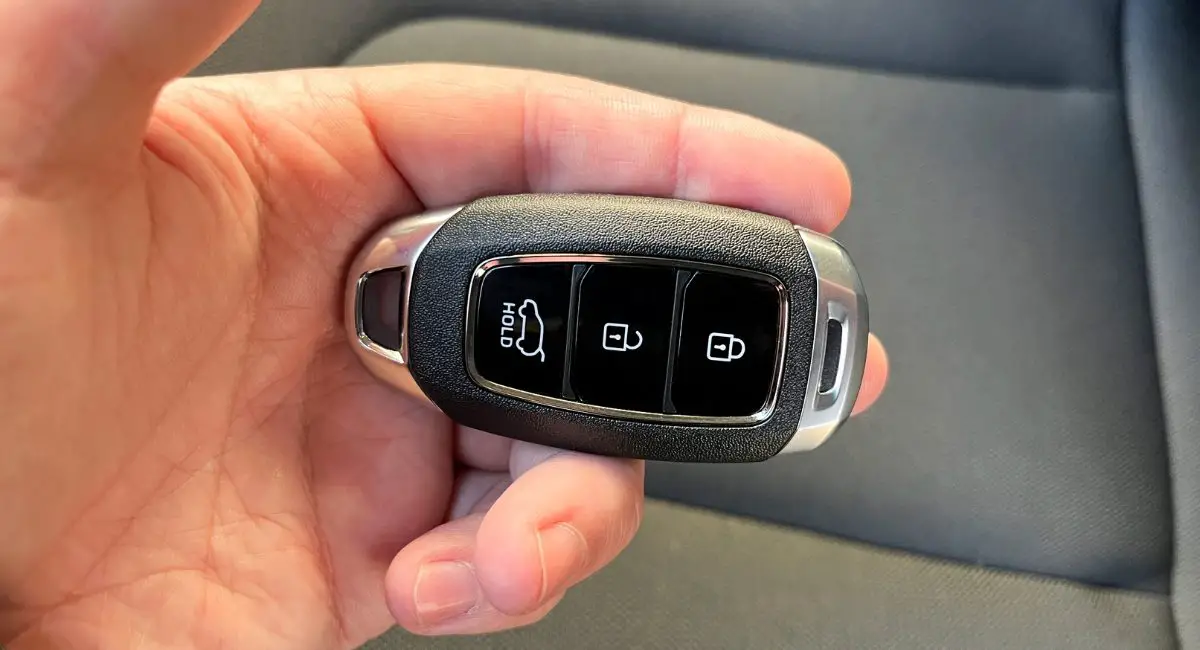In today’s tech-savvy world, key fobs have become indispensable accessories for vehicle owners, offering convenience and security in equal measure. However, as our reliance on these tiny devices grows, so does the need for responsible handling, especially when managing multiple vital fobs.
To carry two key fobs, opt for a dual-ring keychain. It is best to keep both fobs arranged for optimal organization. You can also designate separate pockets or compartments for each fob to minimize confusion and ensure easy access when needed. Additionally, consider utilizing key fob holders or small pouches to provide extra protection and organization for your essential gadgets.
In this article, we’ll look into carrying two key fobs safely, exploring best practices, potential pitfalls, and practical solutions to ensure a seamless experience for users.

Understanding Key Fobs
Key fobs are small, handheld devices that wirelessly communicate with a vehicle or electronic system to perform various functions. But just how prevalent are they?
Did you know that approximately 44% of new vehicles sold in China come equipped with keyless entry systems, highlighting their widespread adoption?
These compact gadgets use radio frequency signals to transmit commands, such as locking and unlocking doors, starting the engine remotely, and activating alarm systems.
But what about their components?
Key fobs typically contain batteries, transmitters, and buttons, all working together seamlessly to provide convenience and security for users.
With their evolution from basic remotes to sophisticated smart devices, key fobs have become indispensable accessories in modern-day living. But how do you ensure their safe handling and maintenance?
Let’s now understand the key fobs, their importance, and how to handle them responsibly.

Risks of Mishandling Key Fobs
Despite their benefits, key fobs are not without their vulnerabilities. Loss or theft remains a significant concern, with research indicating that approximately 26% of vehicle thefts involve using stolen keys or key fobs.
And there’s more on risks of mishandling key fobs, including:
- Accidental damage: Dropping or mishandling key fobs can lead to physical damage, affecting their functionality and potentially requiring costly repairs or replacements.
- Battery drain: Failing to maintain key fob batteries properly can result in unexpected battery drain, leaving you unable to access your vehicle or activate keyless entry features.
- Security concerns: If lost or stolen, key fobs can be used by unauthorized individuals to access your vehicle or property, posing security risks and potential safety hazards.
- Cost implications: Replacing lost or damaged key fobs can be expensive, primarily if they are specialized or require programming, resulting in financial burdens for the owner.
How to Carry Two Key Fobs
Finding the right balance between convenience and security is key for individuals managing multiple key fobs. Considerations such as size, compatibility, and accessibility come into play when determining the most suitable carrying method.
Whether opting for separate keychains or consolidated organizers, prioritizing ease of use and minimizing interference between fobs are essential factors to consider.
So, how do you carry your two key fobs? You’ve got options! Let’s explore some practical ways to handle dual key fobs with ease:
- Dual-ring keychain: Attach each fob to a separate ring on a dual-ring keychain. It keeps them organized and easily accessible.
- Pocket and bag combo: Place one fob in your pocket and the other in a bag compartment. This way, you’ll always have one handy on foot or in your vehicle.
- Key Fob holders and cases: Consider using a small pouch or key organizer explicitly designed for key fobs. These keep both fobs together and prevent them from getting lost in the abyss of your bag.
- Separate pockets or compartments: If you’re carrying a bag, designate different pockets or compartments for each fob. It ensures quick retrieval when needed.
- Clothing options: Some clothing items have discreet pockets or loops for key fobs. Explore your wardrobe for built-in solutions.
- Handbags and backpacks: Attach the fobs to your bag or backpack’s inside pockets or key holders. Easy access, no fuss.
- Wallets or Wrist Straps: Invest in a wallet with a designated key fob slot or use a wrist strap to keep one fob close at hand.
Remember, organization is key! Whether you’re juggling car keys, house keys, or both, find a system that works for you. And if you ever misplace a fob, don’t panic—there are troubleshooting steps and maintenance tips to help you.
Safe Handling Practices
Adopting a proactive approach to handling is paramount to mitigate the risks associated with crucial fob mishaps. Organizational strategies such as using dedicated key holders or organizers can help prevent loss or damage.
At the same time, physical protection measures like protective cases or covers offer an additional layer of defense. Regular maintenance routines, including battery checks and cleaning, ensure optimal performance and longevity for key fobs.
Best Practices for Dual Key Fob Management
Prioritize primary Fob: Designate one key fob as the primary one and use it as your default option. This reduces the likelihood of misplacing or confusing the fobs and streamlines your access process.
Label or mark for identification: Differentiate between the key fobs by labeling or marking them with distinguishing features. This makes it easier to identify each fob at a glance and minimizes confusion.
Regularly test for functionality: Periodically check both key fobs to ensure they function correctly. Always try remote locking, unlocking, and any other features to identify any issues early and address them promptly.
Establish maintenance routines: Incorporate key fob maintenance into your routine. It may include cleaning the fobs, replacing batteries as needed, and inspecting for any signs of wear or damage.
Troubleshooting Common Issues
When handling two key fobs, troubleshooting common issues ensures smooth operation and minimizes disruptions. Here’s how to address some typical problems:
Battery Replacement Procedures
If either key fob is experiencing issues, such as a weak signal or failure to respond, it could indicate low battery levels. To address this, refer to the manufacturer’s instructions for battery replacement. Typically, you’ll need a small screwdriver to open the fob and replace the battery with a fresh one. Ensure proper alignment and secure closure to avoid damage or malfunction.
Syncing Problems
Sometimes, one or both key fobs may fail to sync correctly with the vehicle or electronic system, resulting in connectivity issues. To troubleshoot this, try re-syncing the fobs according to the user manual’s instructions. This may involve pressing specific buttons in a certain sequence or accessing the system’s settings menu. If problems persist, consult a professional technician for further assistance.
Malfunctioning Buttons or Transmitters
If buttons on either key fob become unresponsive or fail to register commands, it could indicate internal issues with the circuitry or transmitter. First, try cleaning the buttons and the surface around them to remove any dirt or debris that may be obstructing proper contact. If problems persist, it may be necessary to seek repairs or replacements from an authorized service center.
Damage Assessment and Repair Options
In cases where key fobs have sustained physical damage, such as cracks or water exposure, it’s essential to assess the extent of the damage before attempting any repairs. Minor damage may be remedied with DIY solutions, such as using adhesive or tape to secure loose components. However, professional repair or replacement may be necessary for more severe damage or internal issues to ensure optimal functionality and security.
What Should I Do if I Lose One of My Key Fobs?
Losing a key fob can be stressful, but fear not! Here are some steps to take if you find yourself in this situation:
1. Search the area
Start by retracing your steps and checking where you last had the key fob. Sometimes, it might be right under your nose! If you don’t find it, move on to the next step.
2. Check your vehicle
Look inside your car, especially if it’s unlocked. Keys often end up in the vehicle unknowingly. If you find them there, consider getting a spare made. If not, proceed to the next step.
3. Gather vehicle information
You’ll need some essential details if you choose a locksmith or car dealership. Identify the type of key you use (more on that later). Also, note down your vehicle identification number (VIN), which you can find on the dashboard or driver’s side door jamb. Don’t forget the year, make, and model of your vehicle.
4. Get a new key.
With an older car, opt for a locksmith to save money. But with a modern car with no spare, contact the dealership. They’ll create new car keys and reprogram them to your immobilizer system. Depending on your car model, you might need to tow it to the dealership.
Remember, losing keys happens to the best of us. Stay calm, follow these steps, and soon, you’ll have a solution.
Can I Have a Key Fob I Bought Programmed for My Car?
Yes, you can have a key fob programmed. If you’ve purchased a key fob independently and want it programmed for your car, here are some options:
Self-Programming
Some vehicles, especially older models, can program the key fob without specialized equipment or a dealership visit. The exact procedure varies from one car to another. Still, it typically involves turning the ignition on and off, pressing buttons on the key fob, and opening and closing doors within a specific time frame.
You must gather all the key fobs you want to program, including existing ones, as most vehicles erase previously programmed key fobs.
Dealer Programming
In many cases, key fobs must be programmed by a dealership. Dealerships use specialized diagnostic tools to program the new key fob to your car. While this method incurs costs, it may be unavoidable for certain vehicles.
Onboard Programming
Some vehicles come with a built-in programming mode. You can pair a key fob through the vehicle’s infotainment system or dashboard controls. This process involves navigating menus, inputting a security code, and following on-screen instructions to complete programming.
Key Fob Cloning
Some locksmiths can create a duplicate or clone if you have a working key fob. The cloned key fob will have the same unique identification code and encryption as the original, allowing it to work flawlessly with your vehicle.
Consult your car’s manual or contact a professional if unsure about the best approach for your specific make and model.
Conclusion
As technology advances, key fobs’ role in modern-day living will grow significantly. By adhering to safe handling practices and implementing proactive measures, users can navigate the complexities of dual key fob management with confidence and peace of mind. Remember, mastering the juggle of carrying two key fobs is not just about convenience—it’s about safeguarding your assets and ensuring a smooth journey wherever life takes you.
